See likes given/taken
| Post info | No. of Likes |
|---|---|
|
Additional Ice functions for kicking, looking.
At the moment, our characters can throw and push varied items on ice to see if it’s durable for walking on. Sometimes it’s a chore, lobbing several stones or slender trunks on ice, then picking them up. So the suggestion is: when standing, I.e. not swimming, allow the characters to “kick” or “stomp” the ice on adjacent tile to see if it’s durable. Also useful to keep existing water hole in use. * Also let the character look at the hole in ice, and estimate the thickness. E.g. “the ice looks as thick as one finger” or “the ice looks as thick as a fist” and so on. * heavily burdened, tired or fatigued characters could have a chance of losing balance and falling. Possibly through thin ice. we don’t have enough dangers in URW January 21, 2021, 07:07:00 PM |
1 |
|
Foreign traders’ merchandise?
Is it possible to mod what items Foreign Traders carry for sale? I.e. can I have them carry salt? Can I have them carry e.g. langseax (I don’t want character to be able to smith themselves) February 03, 2021, 05:46:49 AM |
1 |
|
Putting Out Fires
Title. Currently, afaik, the only way to stop a fire from spreading along a fence or a wall is to deconstruct any wooden structures in the fire's path. We should be able to put out fires by standing next to the fire with a container full of water, "a"->apply the tub/skin/etc. and have this either reduce the fire's size or put it out entirely, depending on how much water was in the container. February 04, 2021, 04:59:37 PM |
1 |
|
Re: Simplifying keystrokes?
By the way, what does everyone here think of this... I was in a village right now looking at items they had available for sale, and looking through all items in one area is a process of going to one tile, hitting enter, going to another tile, hitting enter, going to another tile, hitting enter, etc. Because looking doesn't really take any turns of movement, wouldn't it make sense if when you're in Look mode, and you have something under your target, a small overlay box appears somewhere in the corner of the UI, the objects in that tile appear in the overlay and it updates the information when you move the cursor to the next tile? February 14, 2021, 05:24:25 AM |
1 |
|
Re: How do I hit someone
It can also be noted that the chance to hit are modified by the character's encumbrance, fatigue, and injury penalties, and the resulting roll is then opposed by the opponent's dodge/parry roll. I've encountered enemies that were almost impossible to hit despite my character having very good effective skill. In at least one robber quest case I "wasted" turns to circle the enemy (engaged by hired muscle) in order to attack from behind (as Privateer suggested).
February 21, 2021, 12:35:45 AM |
1 |
|
A very draft of textilecraft -- fibre processing on its' way
So we're adding fibre processing, from harvested plants into yarn, starting with nettles. It's a complex feat(ure) all-in-all and the things briefed here can change as we proceed. Now we're in the middle of brainstorming, study, coding and testing the initial mechanics - and also making changes to existing stuff to the extent that allows this type of new material processing in the first place. Starting with nettles we'll add few new habitats (ponds and wetlands) for them so that the newly featued usefulness will be practical in the wilderness conditions. Nettle harvesting also needs to be changed so that they can be harvested way earlier than currently, without seeds naturally, but in good length for fibre extracting. Fibres obtained will be probably categorized as PLANT item type, for easier spotting and selection from the inventory. For all the fibre processing and spinning yarn it's likely that we'll feature a completely new skill: textilecraft. The fibre processing in general will go through retting, drying and extracting fibres. We'd like to feature water retting based on the temperature, so it can be faster or slower depending on the weather (ie. water temperature), and becoming impossible in the freezing weather. We'd also like to make it possible to extract fibres from (fresh) nettles simply by hand without retting process required. It takes some time, but that's how you would craft a fishing line in the wilderness within few hours. For producing larger quantities of fibres the water retting would be the way to go, of course. Fibres can be spun into yarn either by hand, or with a spindle. The both options will be available. Crafting a spindle is simple, but the actual spinning is something you need to practise. Textilecraft skill would come in handy there, as the beginners surely don't produce yarn all that fast at all. That's some of the to-dos (and actually some dones also) from top of my head to come up with satisfying fibre processing. With this addition I found it better to proceed kind of backwards... So at first I've got some (magically generated) nettle fibre, and a spindle - a new craftable item. Textilecraft menu is set up with the initial options. Retting, drying and extracting are mere placeholders, but spinning yarn is being coded now. Productions times and yield and internal properties of the bundles of fibre, and yarns are on the table. After the spinning code is ready, it's time to concentrate on the preceeding steps. Here's a very draft screenshot where I'll try to code Kuitu Kaumolainen through spinning his first nettle yarn. There's bundle of nettle fibres and spindle on the ground. 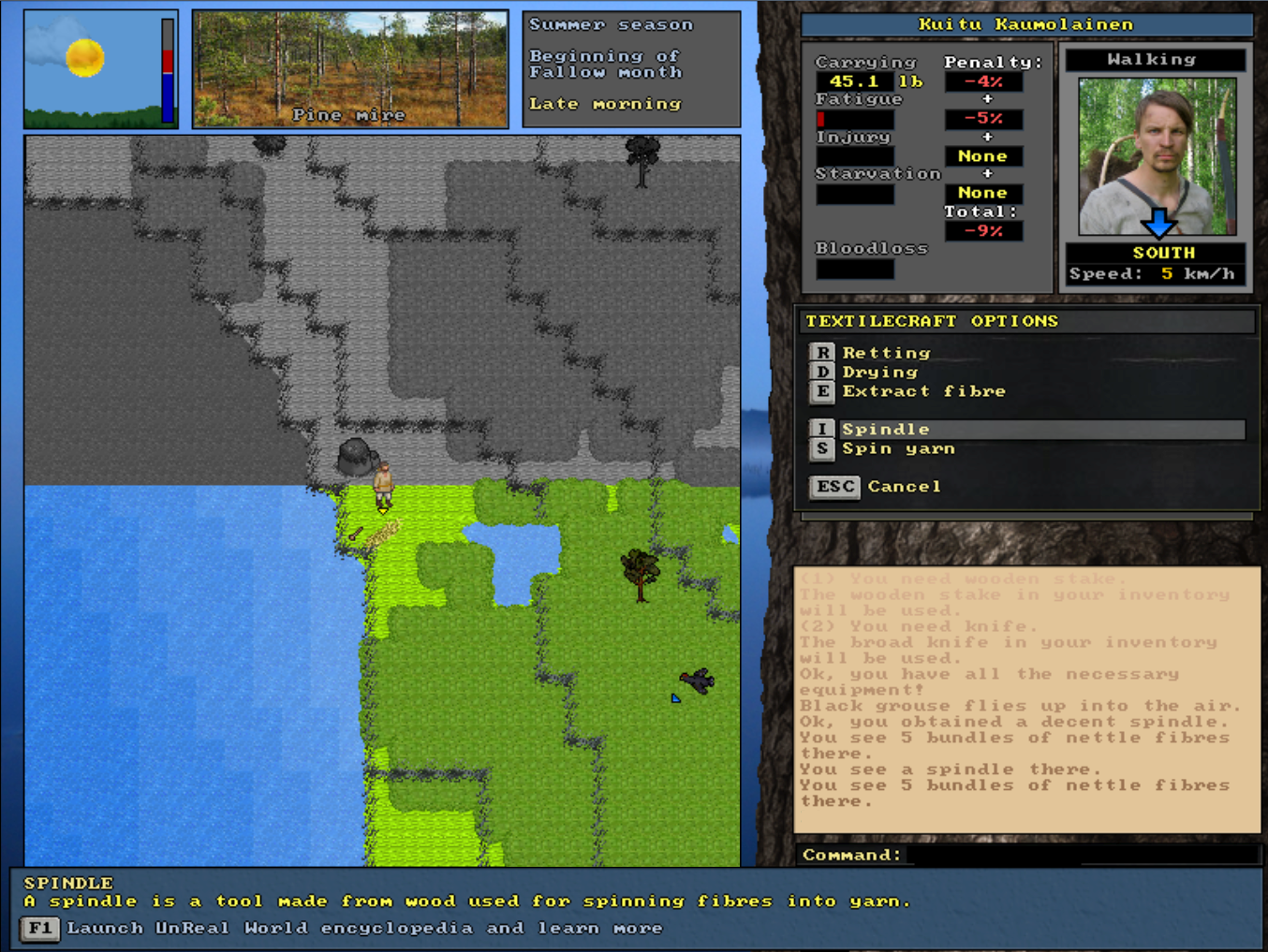 These are future additions - not yet functional in current version 3.63. March 17, 2021, 11:04:37 AM |
1 |
|
Re: Cellar mechanics
Here is my finished cellar. Mostly surrounded by fences, but I put a few traps on the off chance that I might catch something March 25, 2021, 04:19:46 PM |
1 |
|
Fibre processing done
So, the system of processing fibres from hemp and nettle into yarn is now all coded. Small adjustments remain, but we've happily accomplished mechanics for all the work phases and necessary adjustment to data structures. Adding this system of textilecraft has been likely the most laborous single feature to code in the upcoming version. With several other features regarding tying equipment we can talk about sort of cordage overhaul. Soon enough I'll be posting more organized entry about the whole system with screenshots, but now let's quickly cover what hasn't been covered in the earlier textilecraft news. So, the final two additions to textilecraft system were drying the retted plants and the actual extracting of fibre. Drying is simplified. It takes about a week for retted plants to dry before extracting the fibre can be proceeded. And you can basically set them drying anywhere. The idea of extracting the fibres is to break the dried retted stalks so that the woody core shatters and falls away leaving the loose fibres free. Traditionally this was done with a special device called ‘loukku’, but in the game we use more primitive method of beating the stalks for example with a club on a solid working surface. The requirements are similar to softening hides as a last step of tanning; beater and a working surface. Extracting fibres is hard physical work and commonly carried out with several people working together. If you have companions around they will help you with the task. After the breaking phase, obtained bundles of fibre are scraped free from remaining coarse parts and extraneous material. This is done in steps, first removing the biggest extraneous parts and gradually proceeding towards the finer ones. Traditionally special tools, combs and brushes were used to clean the bundles of fibre as effectively as possible. In more primitive fashion it can be also done by whisking, rubbing and whacking the bundles against a hard surface, or with tools at hand. In the game this is the method used, and the equipment available for breaking is applied here as well. All these required phases are done with single textilecraft option. Extracted fibres are obtained in small bundles, eg. "bundle of hemp fibre". These items are categorized as PLANT type in character's inventory. As mentioned before, nettle fibres can be also extracted directly from the stalk by hand even without retting. Although it's slower to mass produce fibre that way it can be useful option when only a small amount of fibre is needed. To do it, simply use extract option directly to freshly harvested nettles. The nettle stem is crushed by hand, and the fibres carefully stripped off. Character's expertise in textilecraft affects to required working time and amount of usable fibre extracted. So as your mastery in textilecraft increases you can expect to get higher fibre yield in shorter time. These are future additions - not yet functional in current version 3.63. May 06, 2021, 04:19:40 PM |
1 |
|
Show statistics without needing to die...
Hi, As the title says, only when you die you can finally see some basic stats about your char: distance traveled, days adventuring, etc. Why not implement a "Statistics" screen, to see your current stats? It can have the following info: - Start date of adventuring - Days adventuring - Distance traveled - # of animals hunted (per species). Don't display zero kills, to have it cleaner, or fish! - # of animals trapped (per species) - # of Njerpezs killed - # of buildings and/or total area of buidings - # of traps (per kind) - Total length of fences - # of quests completed - Total value of inventory - # of cultures met - gain per skill since beginning (ex: +10 bow, +15 hideworking, etc.) - Whatever other interesting things you desire  Shouldn't be too complex. Thoughts? Regards, Utumno. May 08, 2021, 06:37:43 PM |
1 |
|
Sneak preview of textilecraft system with screenshots and additional insight
Time for a little sneak preview with our textilecraft test character Kuitu Kaumolainen. Some of the stuff mentioned here has been mentioned before, but a summary about textilecraft is in place now. With some sdditional insight and sidetracking included. So, the biggest single addition to the upcoming version is featuring mechanics to extract fibres from certain plants and process them into yarn. For this, a new TEXTILECRAFT skill was created, and lots of spin-off features regarding fibre processing and cordage also followed. Fibres can be extracted from nettle, hemp and flax - which has been added as a new cultivated plant. Let's start from there ... Flax Flax is an old cultivated textile plant, but in Iron-Age Finland it wasn't even as commonly grown as hemp. One reason for this is that flax doesn't survive in the very north so in the game it's grown only by certain cultures south of Kaumo. As a curiosity, the finnish word for flax ('pellava') originally meant the nettle plant ('nokkonen') which speaks about importance of this age-old wild source of fibre. But nevertheless, flax is in the game now and it can be grown, harvested and processed for fibre. 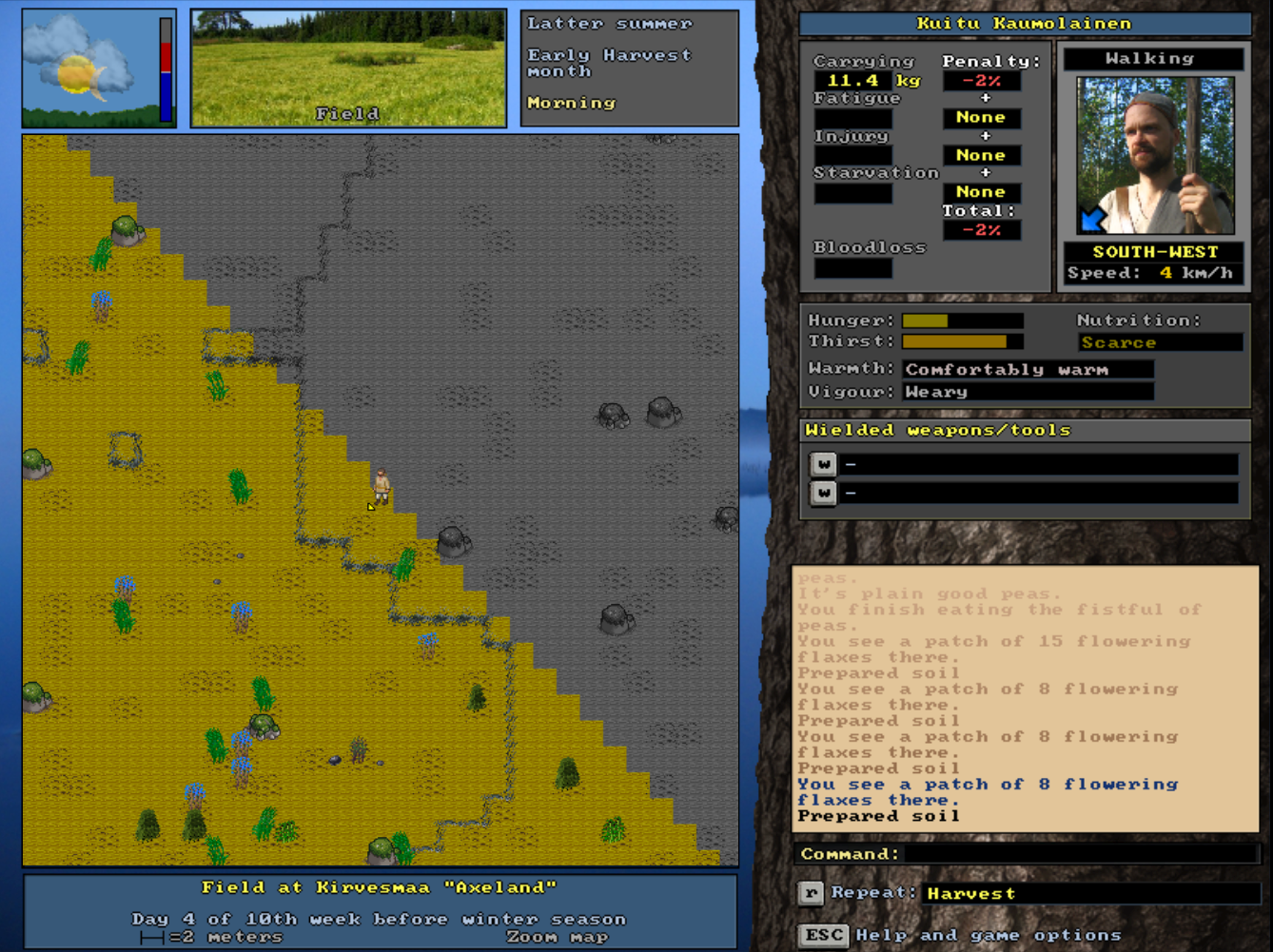 Kuitu Kaumolainen has found his way to Kiesse, a region where flax is grown. At Kaumo where he's from they only produce nettle or hemp fibres. Blue flowering flax is easily spotted from the field, and it could be harvested for fibre already. Textilecraft options Processing plant fibres into yarn involves several stages of work, and it's all done by using your TEXTILECRAFT skill. Character's expertise in textilecraft affects to required working times and the amount of usable fibre or yarn produced. After the plants are harvested the fibres must be then separated from the plant's stalks. This process is called "retting", and it is done by soaking the plants in the water for several days. Sufficient soaking time depends on the water temperature, with the warmer being faster. 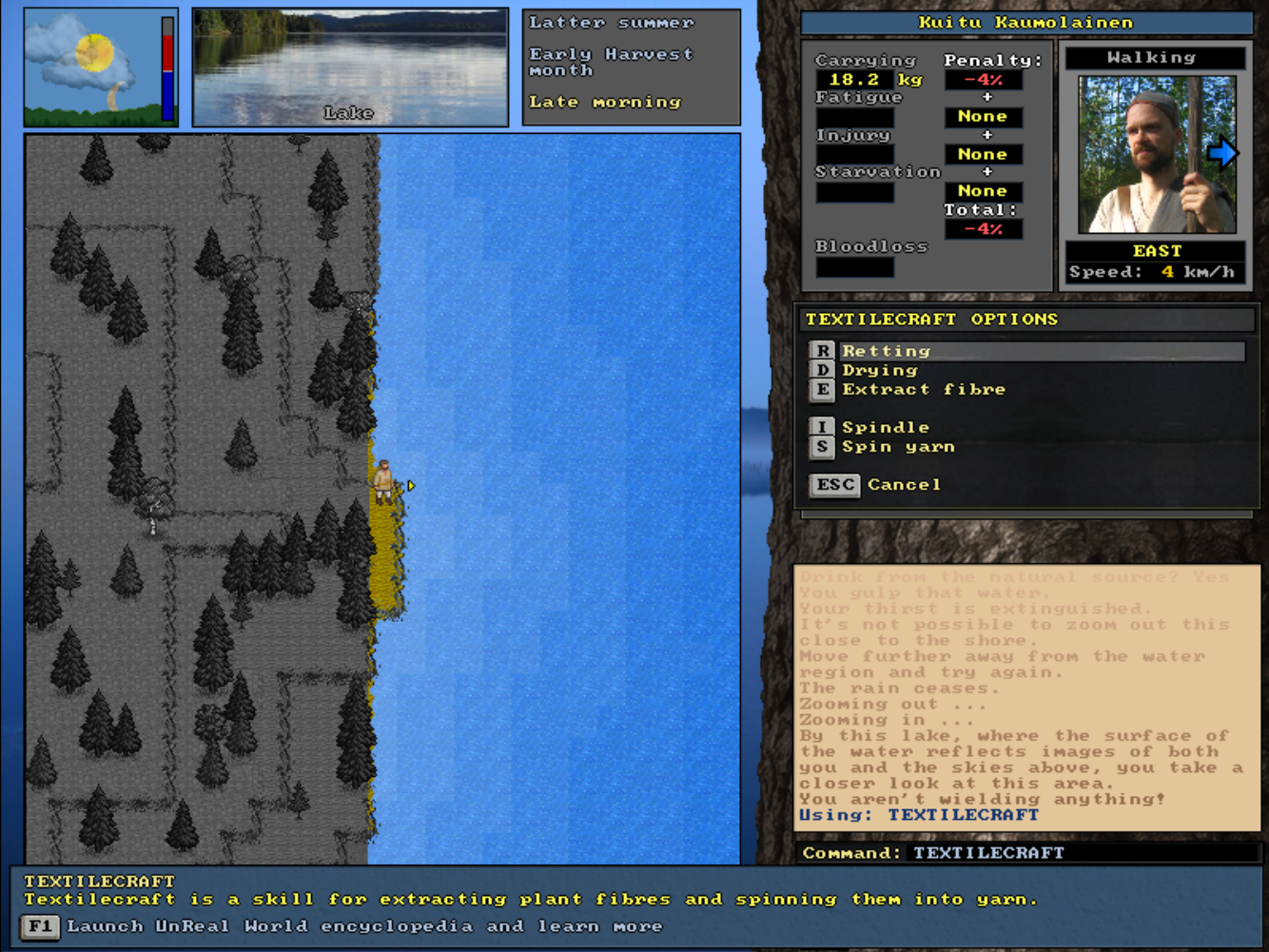 Kuitu Kaumolainen harvested 100 flaxes and headed by the lake to start retting the stalks. Here you can see all the textilecraft options to proceed with fibre extracting and spinning them into yarn. Extracting fibres is hard work It took two weeks for Kuitu's flax to soak properly. After that it took one more week to dry them. And only then Kuitu can start extracting the actual fibre from the stalks. Extracting fibres is done by breaking the dried retted stalks so that the woody core shatters and falls away leaving the loose fibres free. The stalks are beated for example with a club on a solid working surface. Extracting fibres is hard work and commonly carried out with several people working together. Traditionally there has been a custom to arrange specific work parties for processing fibres of each village together with the neighbouring people. And in the game your companions can actually help you with the task. Obtained bundles of fibre are then scraped free from remaining coarse parts. Traditionally special tools were used, but it can be also done by rubbing and whacking the bundles against a hard surface, or with tools at hand. 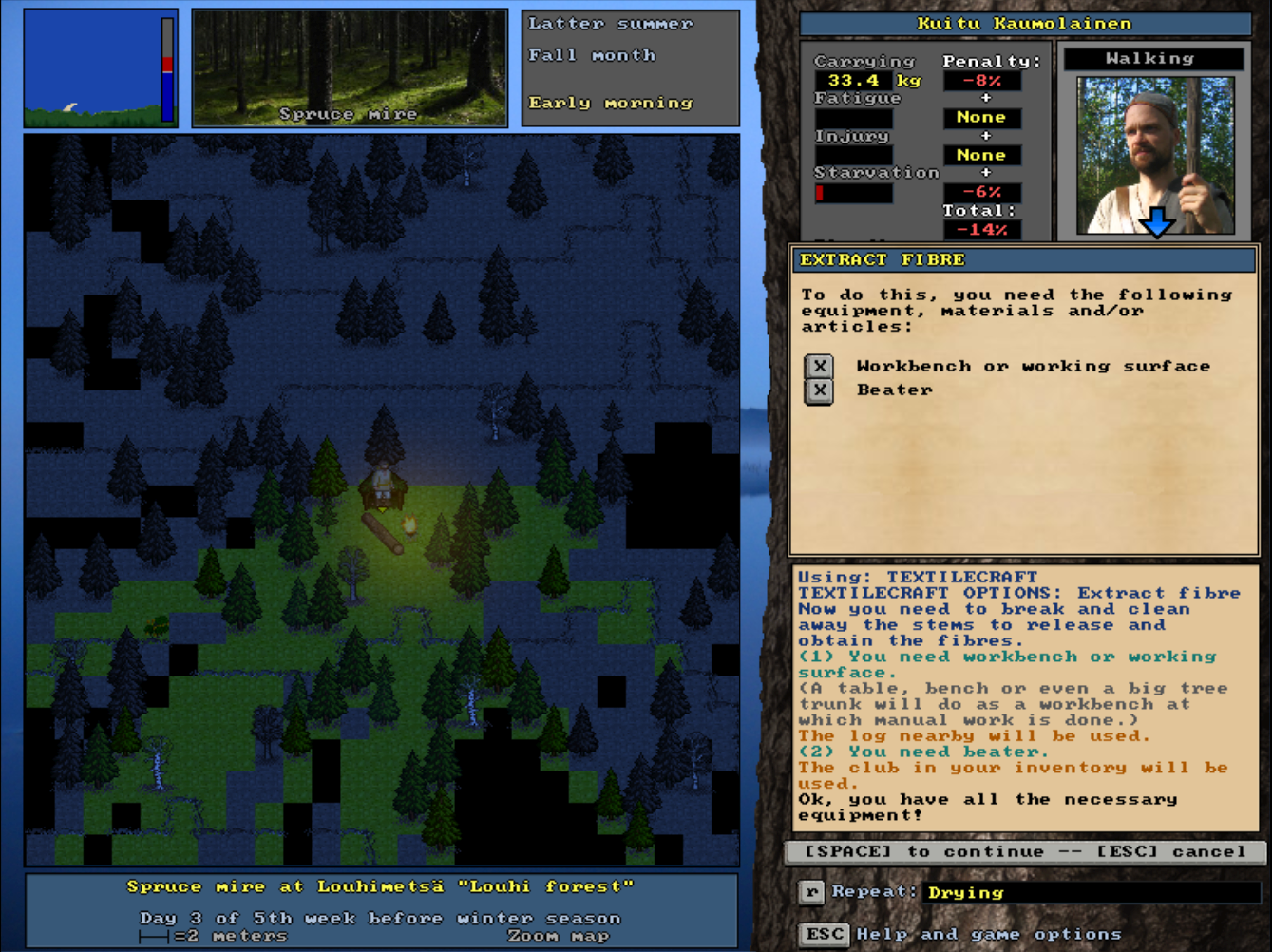 Kuitu starts extracting fibres from the dried retted flax stalks at his shelter. He is about to beat the stalks with a club on top of a log. These dried retted stalks could have been also stored for future and the fibre extracted when there's time and need for that. Spinning yarn It took lees than half an hour to extract the fibres from his 100 flax stalks and Kuitu got 16 bundles of flax fibre. Fibres can be then spun into yarn either by hand, which is slower, or using a spindle. Spindle is also a new craftable item, and very easy to make. So Kuitu crafts a spindle and starts spinning. He decides to go for full length yarn. When starting spinning it is possible to choose how long yarn you wish to spin on one go. 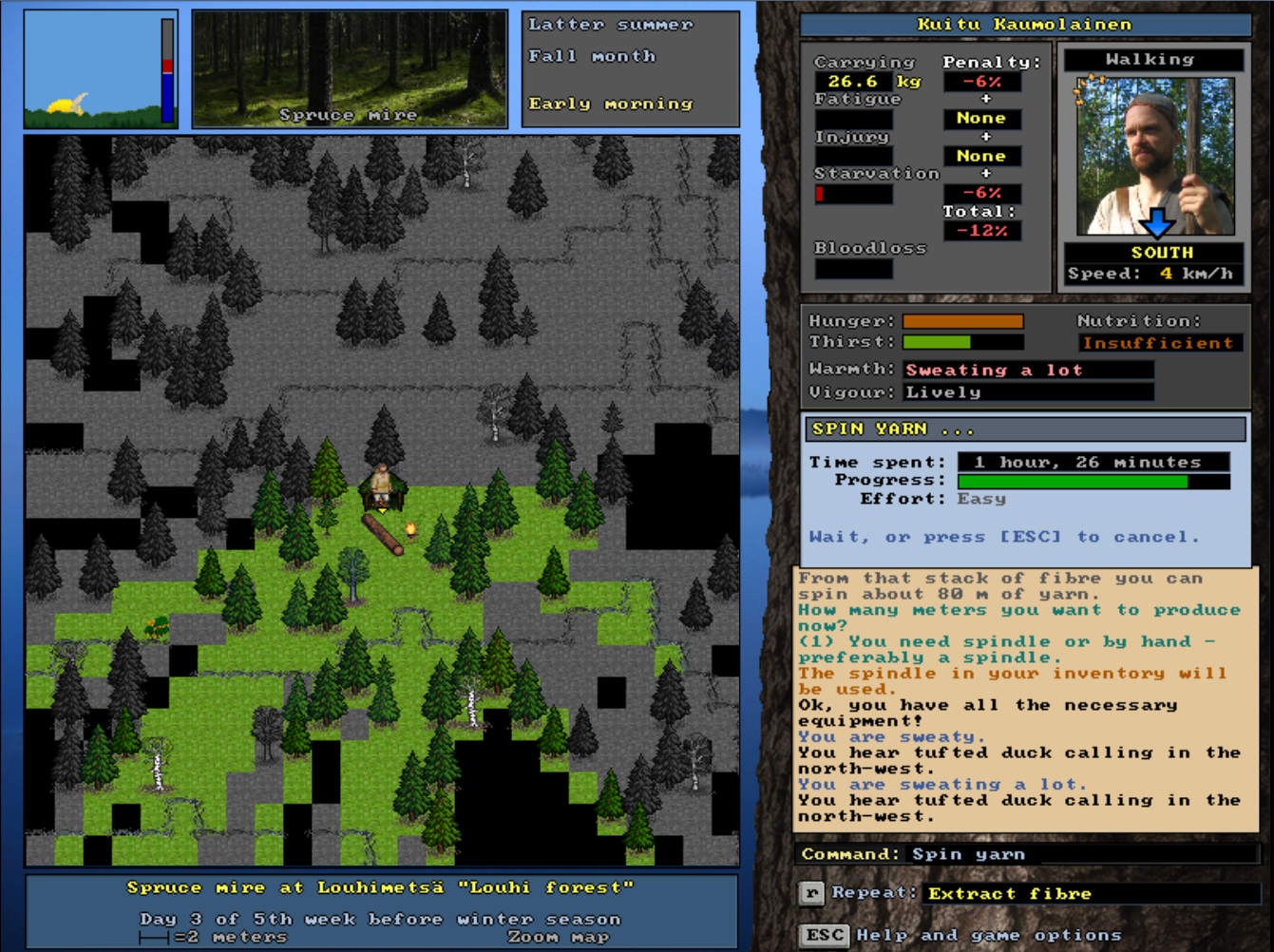 Kuitu manages to spin 80 meters of linen yarn in less than two hours. It could be then used in crafting of different items such as loop snares, arrows - or fishing rods. Nettle specialities In the next version it will be also possible to craft fishing rods, and hooks out of wood or bone. And a working fishing rod naturally needs a line too. Now Kuitu has his linen yarn which could be used as line, but the whole process of extracting flax fibres with retting and drying took weeks. That's quite a long time if there's an urgent need for little piece of yarn. Luckily there's also faster wilderness condition option for utilizing plant fibres - and that is a nettle. Nettle fibres are a speciality as they be extracted directly from the fresh plants without retting and drying processes. To do it you can simply use "extract fibre" option directly to freshly harvested nettles. This method takes more time, but is an useful option when only a small amount of fibre is needed. The nettle stem is crushed by hand, and the fibres carefully stripped off. It doesn't take long before Kuitu finds some nettles. Textile plant harvesting is made possible for fibre even when they are still growing. 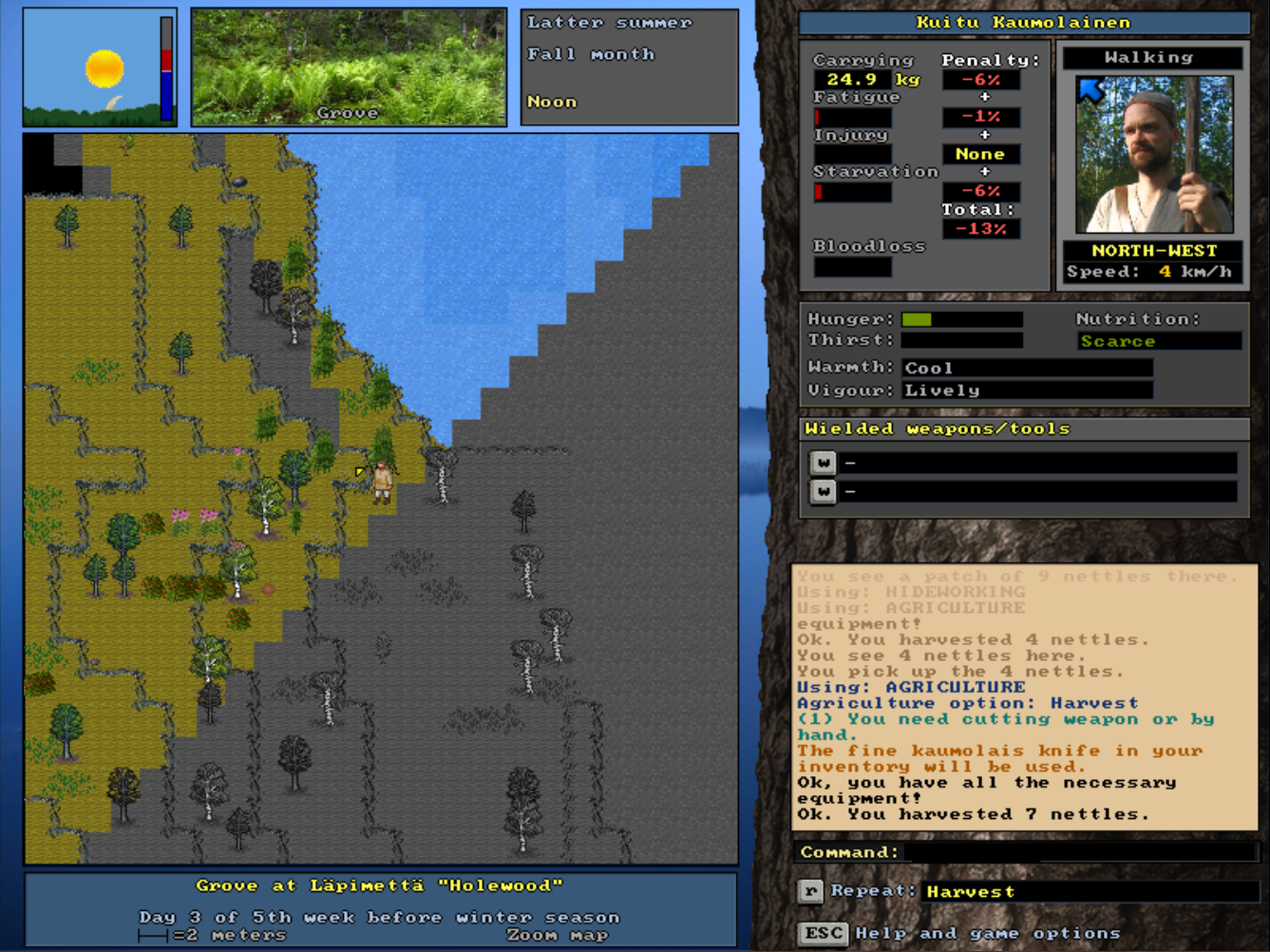 Kuitu harvests some nettles. Then he simply extracts the fibres by hand, and spins some nettle yarn. If he would like to produce a lot of yarn, this would be too slow to be practical, but now he's only after fishing rod line, Wooden hook, nettle yarn - and baits Kuitu finds a slender tree trunk, fashions a wooden hook out of a branch, and proceeds to assemble a fishing rod. Now we should mention that In the upcoming version usage of baits in fishing is also featured. Using baits is not necessary, but naturally highly recommended. Catching a fish every now and then without a bait is still possible, but for reliable rod fishing and decent catches baits are now quite essential. You can use pretty much every food item as a bait and portion of the selected item will be used during the fishing attempt. Pieces of raw meat and fish can be considered decent baits for predatory fish, but for example crumbs of bread may also work for some fish. You can also use a whole small fish, eg. roach or perch, in order to attract a bigger predatory fish. With this addition in effect the type of fish caught with rod fishing is now more dependant on the baits used. It's not likely that you'll catch a pike with an empty hook, but having a small roach as a bait might work. And that little roach might have been caught with quite moderate bait such as bread crumb, or even with some tasty vegetation. 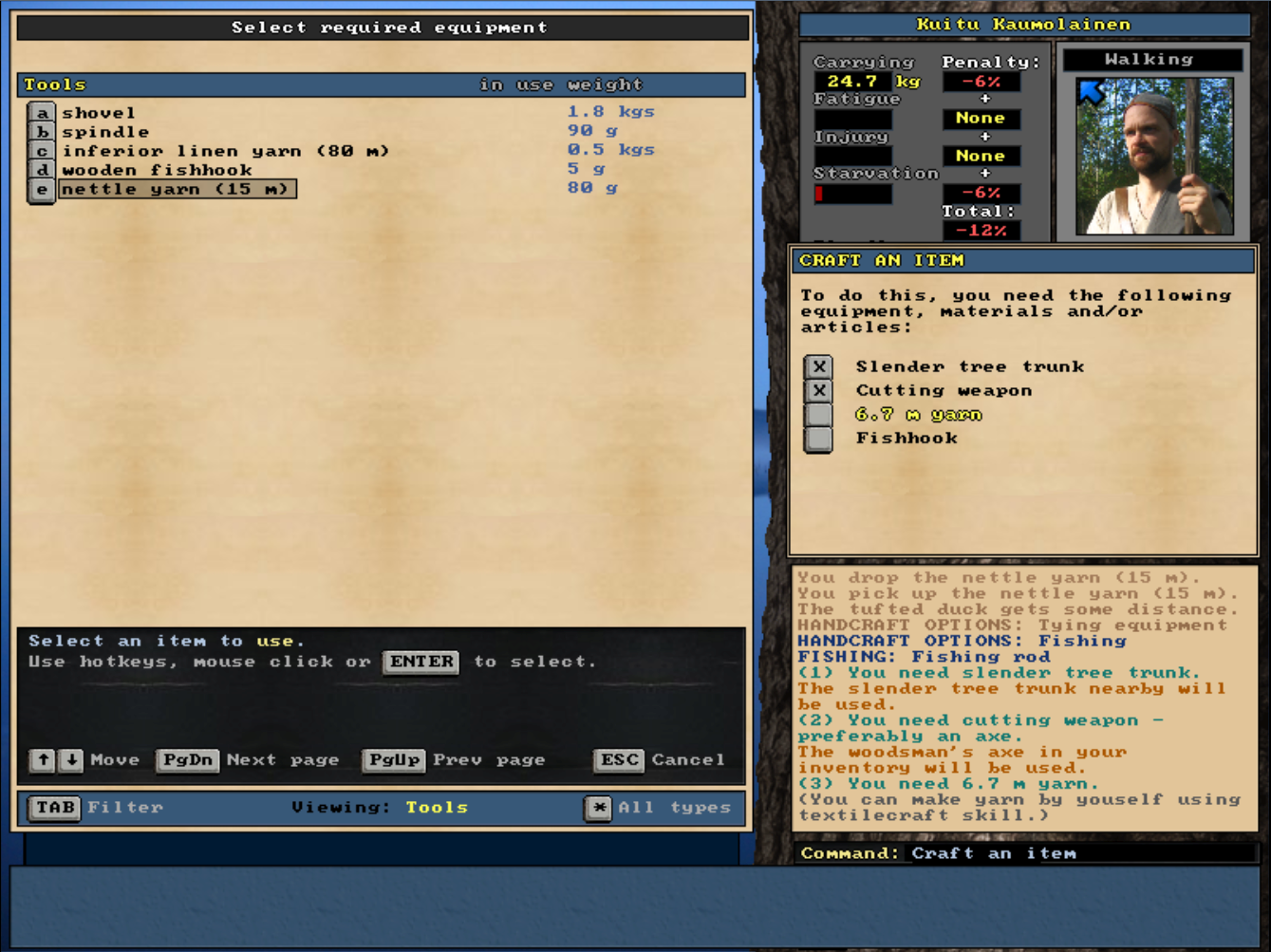 Kuitu makes his survival fishing rod, with a wooden hook and nettle yarn. The work with the several less laborous features continues but we're getting closer to release every day. It's always quite impossible to say when everything is completely wrapped up and working, but maybe - just maybe - we might have this version out in june. Cheers! For those who are more curious about the real life practises here's a short documentary in Finnish showing how the flax is processed. Having read the above I trust you will understand what is happening even without subtitles. The gear used differs slghtly from the more primitive method of the game, but the steps are the same; sow, harvest, ret, dry, extract, spin. https://www.youtube.com/watch?v=TNFD_CUlxZU May 11, 2021, 03:52:38 PM |
1 |


